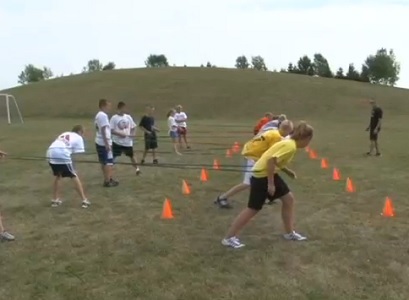Making Youth Fitness Training Fun with Resistance Bands

A t least once a week, I am asked about youth fitness training using bands, and in most cases, all I can envision is kids being put through a grueling workout using big bands that literally throw them around like a human slingshot .
OK, maybe I am a little off, but I see a lot of things on YouTube that scare me when it comes to training young athletes.
So here’s a tip on how to have your athletes naturally enjoy training:
If you really want to make youth fitness training fun, start making the training game-oriented.
My goal with any young athlete resistance band workout is to get them to train instinctively because when they reach that level, they are as close to a game situation as they possibly can be. At that moment, training becomes fun because athletes are thinking about competing, not training.
Over the past several years, I have had the chance to test some resistance band training games with youth fitness training and wanted to share some of these simple training games with everyone in the IYCA.
Video – Partner Zigzag training for Young Athletes
Young athletes need direction and a target. I find cone drills like a simple Zigzag drill to accomplish both of these. The key to this drill is making sure athletes have a good understanding of how to shuffle or backpedal and how to hold for their partner. Once this is accomplished, Zigzag drills are very easy to implement. Within about 2 minutes, you will have taught and trained a young athlete how to decelerate in the frontal and sagittal planes while developing good reactive strength from their trunk, hips, and quadriceps.
Video – Ricochet
Ricochet is a drill I developed to teach deceleration in youth fitness training. It has become a training game because athletes can compete while performing it. It can be used for all band locomotion drills but can also be effectively used for strength training drills as well. The video below demonstrates how it works with locomotion. It is used for strength training drills in essentially the same way, with athletes alternating back and forth during the strength exercise. This format is great for developing teamwork, but it is also very effective at improving strength endurance—especially when done for a 2-minute time interval.
Video – Partner Reaction
This drill is where athletes get to test their partner, who now is their opponent. Athletes face off where one is offense and one is defense. Defense must react to offense and try to mirror them during the drill. Best drills for this are shuffle or turn-and-go drills. Also, 2-step deceleration drills work well with this setup. This is also a coaching favorite because you allow the kids to dictate the start and stopping point of the drill.
1-Minute Partner Challenge
The 1-minute partner drill is fun because you can do it with 2, 3, 4, or 5 athlete teams. You can do all the same exercise or you can have each athlete do a separate exercise for 1 minute. The goal is to get as many reps as possible in 1 minute before transitioning to another exercise. My favorite band exercise for this are:
- Band Push ups
- Assisted pull ups
- Split Squats
- Squat Jumps
- Front Squats
- Overhead Press
- Turn and go (touching a cone)
To make this entire resistance band training game experience just a little more motivating, all these games can be played anywhere because bands are so portable. This means:
- Kids can train at their practice site and not have to go into a smelly weight room
- Trainers can have athletes train outside where it is much more enjoyable to do
- Coaches can throw these types of drills into practice any time and supplement conditioning with strength training
To be a successful youth coach, you must find ways to motivate young athletes starting from a very young age and continuing throughout their high school years. Resistance bands can provide a definite change of pace that athletes find fun and challenging at the same time.
Getting BETTER with BANDS
Dave Schmitz
P.S. On this final video, I thought you would enjoy watching 2 very special young athletes have some fun competing while training in bands. Pay special attention to the laughing that comes along with this type of training. To this day, Kenzie and Carter Schmitz (yep these 2 are mine; I thank God every day) still talk about this experience and when they will be able to do it again. This is yet another reminder that youth fitness training doesn’t have to be filled with boring, routine drills; competition is a great thing!
Video – Kids Getting The Best of Some Fitness Pros
If you are looking for a fun and exciting new component to add to your training programs that will have your young athletes performing their best then check out the IYCA Resistance Band Course. In this course you will learn how to use one of the most versatile, and effective, training tools for young athletes!
